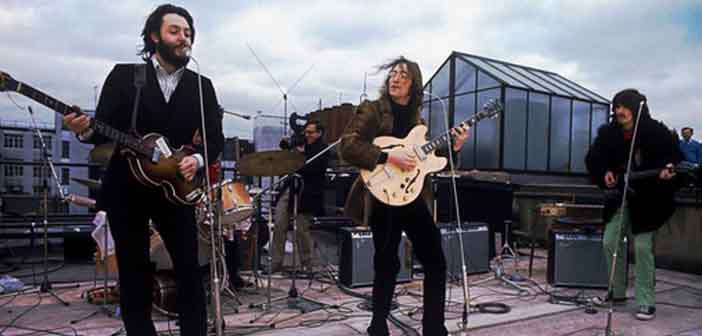By Kevin Boyd
First published here, 30 January 2019
50 years ago today, on 30 January 1969, The Beatles, along with temporary fifth member Billy Preston, ascended the last few steps to the hastily-constructed wooden platform that passed for a ‘stage’ on the roof of their Apple Corps headquarters at 3 Saville Row in fashionable Mayfair. Guitars, amps, keyboards and a drum kit were already assembled, facing the empty London skyline in a conventional arrangement, but this was to be far from a conventional performance.
Beatles lore, and indeed, the majority of conventional rock music histories, have for the subsequent half-century taken this to be the Beatles’ ‘final performance’ or their ‘last concert’, but it was in fact neither. The following day’s recording in the basement studio of the same building or the mid-February session that would produce nascent tracks for their final album Abbey Road could each lay claim, in one way or another, to being their ‘final performance’ as a collective unit. As for this being a ‘concert’ – only the most generous definition of that term could accommodate what was about to take place. This was an open-air recording session that, quite by chance, just happened to have the smallest of audiences. But history will record it as the ‘rooftop concert’ and, at this distance, it seems churlish to dispute such a definition.
What is indisputable is that it was a bitterly cold Thursday morning in the middle of a typical London winter and the musicians struggled to keep warm while the crew checked their camera gear and changed reels between songs. At one point, George Harrison is seen ineffectively attempting to warm his freezing fingers on a lit cigarette. Such were the wintry conditions that Ringo Starr chose to wear a striking red raincoat, possibly belonging to his wife Maureen, and John Lennon donned what may or may not have been Yoko’s fur coat. Only Paul McCartney seemed largely oblivious to the temperatures, foregoing any form of winter wear and braving the freezing conditions in nothing more than a dark suit and open-necked shirt.
As the cameras began to roll, The Beatles performed five of the songs they’d written and rehearsed during the previous four weeks for what had started out as a TV special about the making of a new album and would eventually become their final theatrically-released film Let It Be. The songs were all nominally up-tempo and some were performed in multiple versions. They were: Get Back (three takes); Don’t’ Let Me Down (two takes); I’ve Got A Feeling (two takes); One After 909 and Dig A Pony (one take each).
The location was a compromise. The weeks of filming and rehearsing had been punctuated with regular discussions on how the film might end. There was always likely to be a performance of some sort, but as the tensions and personal grievances that characterised the sessions ebbed and flowed, each of the ever-more grandiose ideas for a climax was first adopted with enthusiasm, then allowed to fall by the wayside until they were left with a shortlist of one – they would play their songs on the roof. Even then it was never certain the thing would go ahead until the eleventh hour, with discussions and debate ongoing as late as the day before, by which point it must be assumed the stage was already built and ready to go.

On the day itself, ostensible producer Glyn Johns supervised from the rooftop, while several of the countless wires and cables that littered the makeshift ‘stage’ snaked down a number of floors to the basement studio where George Martin and Alan Parsons committed the results to tape via recording consoles borrowed from EMI’s Abbey Road studios.
Director Michael Lindsay-Hogg’s cameras captured the events from several perspectives: One camera operator lay on his back on the cramped roof to obtain close-up shots of the musicians; others recorded the reactions of various, occasionally perplexed, passers-by in the streets below; still others prowled the corridors of the Apple HQ capturing the very moment the Police entered the building as a result of complaints from neighbouring businesses.
It took The Beatles a while to feel their way into the performance. The opening take of Get Back is a little laboured and belies the hours of rehearsals and numerous, much more competent, run-throughs they’d had in the preceding days and weeks. Lennon needs help with his own lyrics on more than one occasion – he has a crew member sit uncomfortably at his feet with a clipboard during Dig A Pony and conspicuously flubs the words to Don’t Let Me Down – but by the end they’re having fun and playing up to the cameras. McCartney revels in the sheer absurdity of the whole thing, improvising a line in Get Back – “You’ve been playing on the roofs again… you know your momma doesn’t like it… she’s gonna have you arrested!” – as the less-than-amused Old Bill breathe down his neck.
After 42 minutes it was all over – partly due to Police intervention, partly because they’d captured passable takes of each of the songs in their intended repertoire, but most likely because The Beatles had no intention of hanging around a freezing London rooftop for any longer than was strictly necessary.
A slickly-edited version of the resultant performance formed the climax of Let It Be on its eventual release in May 1970, by which point it was public knowledge that The Beatles were no more. It’s an imperfect epitaph to what were perhaps the perfect pop music phenomena. A little rough around the edges, but infused with a spirit it’s hard to deny, and all the more powerful for its slightly ill-disciplined raggedness.
